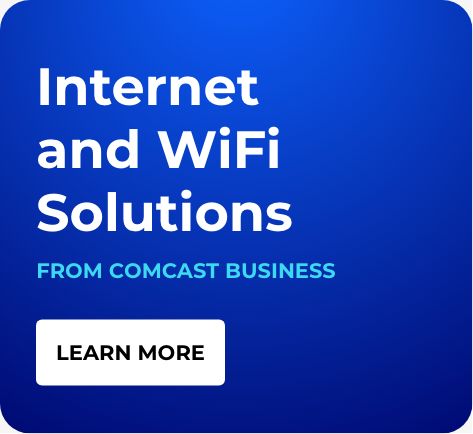Reducing Business Friction to Deliver Better Experiences

In today’s business climate, friction of any kind―from putting callers on hold to unreliable in-store Wi-Fi―can make the difference between a happy repeat customer and lost revenue opportunities. In fact, a Forbes article reported that half of customers surveyed switched brands after a poor interaction, often staying away from those brands for up to two years.1
What can businesses of all kinds do to avoid friction, and how can network infrastructure play a critical role in reducing friction? This white paper looks at what friction’s impact can be, and how businesses can plan now to mitigate it today and in the future.
Business friction defined
The concept of business friction isn’t new―it’s anything that prevents or dissuades customers from buying your products or services. For customers, friction can be long wait times on hold, products that are out of stock or a bad experience with a company’s website. And friction is just as big an impediment to business transactions as it is to consumers.
Still, many B2B companies have not put a significant emphasis on friction, often forgetting that corporate purchasing decisions are also made by those same consumers who have had great experiences with companies like Amazon and expect that same “consumerization” to be applied to business transactions as well.
Friction’s bottom-line impact
As more customers demand frictionless experiences, businesses must take note of how friction can impact the bottom line. Clearly, reducing friction creates brand loyalty. According to the Forbes article, businesses lost more than $60 billion in 2016 to friction such as poor service, a $20 billion increase over the previous three years.2 Moreover, previous research indicates that most Generation X buyers—those in the prime of their consumer purchasing years—will avoid high-friction vendors for as much as two years after a bad experience, such as having to explain the same customer service incident over and over as they are passed from agent to agent.
Importantly, friction is a critical barrier to what may be the most important reason why consumers shop online: convenience. Research indicates that convenience is the chief reason why consumers shop online, cited far more often than price, selection or other factors.3
Removing barriers makes it easier to buy from a business, yet according to Salesforce, even though 82% of business buyers want the same B2C frictionless experience, less than 30% of B2B customers say their suppliers are currently providing an excellent customer experience.4 And, since the customer experience has become one of the most important factors driving digital transformation in today’s businesses, decreasing friction can enhance the contextual interactions that deepen relationships.
Many case studies have shown that reducing friction leads to increased revenues and better business outcomes. A study highlighted on the MarketingExperiments blog found conversion for a VoIP phone service organization skyrocketed by 262% after it reduced the difficulty of navigating its customer quotation landing page by upgrading an unwieldly quote form to an easy-to-use interactive tool.5
Frictionless front-runners and what they do
Although postal mail has decreased as a percentage of overall communications, the need to ship documents and packages through the U.S. mail is still a vital part of nearly every business, and Stamps.com helps reduce friction for mailers of all kinds. By eliminating the need to visit the post office for everything from purchasing postage to calculating shipping rates, Stamps.com gives every business a virtual post office at their location. This enables business owners and employees to print their own customized stamps, track packages, schedule pickups and even order supplies from the postal service―all without having to leave the office. And then there’s Uber. Perhaps the best example of a frictionless enterprise, Uber integrates every aspect of transportation into a single, simple app, from predicting when the driver will arrive and when riders will reach their destination, to a choice of predictable price levels, to handling payment, tipping and driver reviews with a touch of the screen. When one considers the unpredictability of hailing taxis, it is clear why the Uber experience has driven the company’s explosive growth in the past decade.
Key considerations for becoming frictionless
Delivering a multi- or omnichannel experience that offers customers choices of how to interact with the business is critical. Just as consumers often begin searching for a product on a retailer’s web page, narrow down choices on their mobile app and finally select their product at an in-store kiosk, 61% of B2B sales inquiries and product research now start online rather via email or phone call, according to Salesforce, which also reports that more than four out of five business purchasers also want a consumer-level experience regardless of how they interact with their vendors and sales contacts.6 What’s more, two-thirds of those surveyed by Salesforce have already switched B2B vendors to achieve that. If a business isn’t embracing an omnichannel strategy to help reduce friction, its competitors certainly are.
Businesses must identify those areas of friction that currently exist in their processes. In many cases, this could be a difference between the information provided about products and services and the actual products and services themselves. Businesses need to ensure that customers and prospects have the right information and knowledge they need to make informed decisions based on their needs―and that their websites and landing pages reflect that information.
They should also consider the sales process to ensure customers need not complete multiple, repetitive forms or engage with multiple representatives to get the information they need to make decisions or purchase products. The more steps that can be eliminated, the happier customers will be.
Businesses should also focus on segmenting customers by their needs and buying behaviors. In doing so, they can deliver a custom-tailored buying experience for each customer segment, further enhancing their relationships. For example, small companies that purchase sporadically have different requirements from multinationals that use formalized, technology-driven business processes. Driving toward a frictionless environment often requires a shift in business culture, meaning employees must not only look at how they interact and work but think in different ways to develop a customer-centric business model.
Also key to delivering the most frictionless experience is the way technology facilitates better customer interactions. A recent article in the MIT Sloan Management Review found that businesses need to personalize and customize their online selling process through the adoption of high-performance technology and new, customer-centered business models.7
How the right network foundation can reduce friction
Since high-performance technology is critical to delivering a frictionless experience, the underlying network becomes even more important to ensure that different technologies, applications, databases and users are connected in a way that streamlines how customers search for, buy, get, use and pay for services.
First, feature-rich applications, rich media streaming and data-intensive interactions demand that an increasing amount of bandwidth is available to support new users, devices and workloads. Back-office users increasingly need high-capacity connectivity to process huge amounts of data―both transactional and unstructured―and make sense of the data deluge to deliver actionable business analytics. To achieve these goals, businesses are increasingly replacing or augmenting existing legacy networks with gigabit connections that remove bandwidth constrains, enabling businesses to deliver consistently fast and reliable connections that can power frictionless interactions.
Reliable, high-speed networks also power best-in-class Wi-Fi, enabling businesses to support both employees and customers on premises with the capacity they need to check inventory, collaborate with finance to help close a deal or check in with colleagues while engaging with a vendor on site.
As business demands evolve, so too do networking demands. As a result, many businesses find that deploying a software-defined network (SDN) and software-defined wide-area network (SD-WAN) provides the flexibility they need. SDNs can provide insights into network performance and capacity across the enterprise, enabling teams to quickly add bandwidth to support a spike in volume or simply manage the entire network across multiple sites from a central location, easing management burden and freeing up employees to be more productive. This increase in network visibility also helps IT and networking professionals spot issues in real time so they can be addressed even before a single customer is impacted. The result is more efficient operations at a lower overall cost.
Conclusion
Frictionless experiences must be the new normal for every business, from small-town auto shops to digital startups to global conglomerates. Frictionless operations must power every customer interaction, no matter which device customers want to use, what time of day or year it is, or where customers are located around the globe.
Since technology is the engine that powers frictionless engagements, network flexibility and bandwidth become increasingly important in underpinning a frictionless environment by creating a fast, seamless, omnichannel experience that can adapt with the ever-changing needs of a business.
A flexible, fast network allows stakeholders to more seamlessly deploy essential back-office applications like inventory management. It also enables the connectivity necessary to link up other locations, to facilitate collaboration for improved customer service and ensure integration of physical and online storefronts. The net result of all these benefits: reduced friction in every buying situation.
Next steps
Comcast Business has the largest IP network in the nation, serving the needs of small business through large enterprise customers. Technology solutions range from fast, reliable fiber Ethernet and Internet connectivity to voice, video and Managed Solutions. Comcast Business is powered by an advanced Gig-speed network and 24/7 technical support.
Comcast Business offers a secure, high-performance, scalable system designed for heavy data processing loads, enhanced application performance and secure access to cloud or data center. Advanced network solutions help create memorable experiences and enhance customer satisfaction and employee productivity.
Learn more at business.comcast.com/enterprise.
[2]Ibid.
[3]"Are Your Customers Encountering Friction?” SignalFire, June 8, 2018
[4]"New Research Uncovers Big Shifts in Customer Expectations and Trust,” Salesforce, June 5, 2018
[5]"B2B Lead Gen: A/B Split Test Helps Increase Quote Requests 262%,” MarketingExperiments, Sept. 26, 2012
[6]Ibid. footnote 3
[7]"Why Customer Experience Matters for B2B,” MIT Sloan Management Review, Feb. 1, 2019
Across all industries, friction of any kind can make the difference between repeat customers and lost revenue opportunities for businesses. Learn about the impact of business friction, and how businesses can avoid friction with the right network infrastructure.
Locked Content
Click on the button below to get access
Unlock NowOr sign in to access all content on Comcast Business Community
Resource Center
Learn how Comcast Business can help
keep you ready for what's next.











